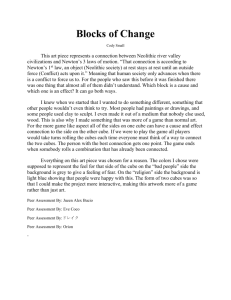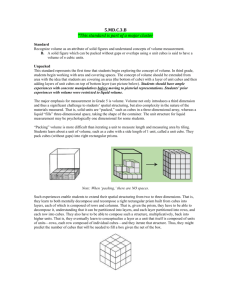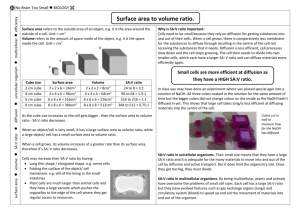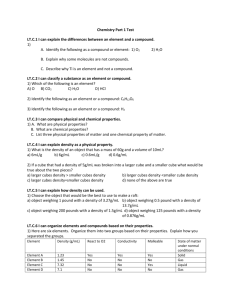Why are Cells so small Lab
advertisement
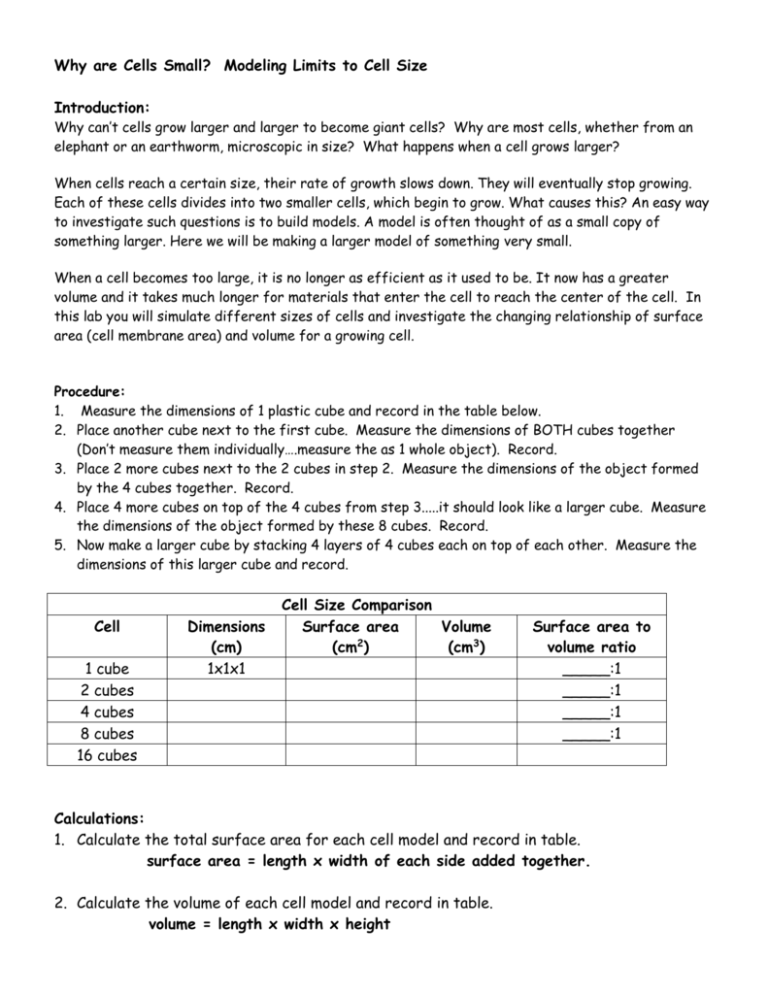
Why are Cells Small? Modeling Limits to Cell Size Introduction: Why can’t cells grow larger and larger to become giant cells? Why are most cells, whether from an elephant or an earthworm, microscopic in size? What happens when a cell grows larger? When cells reach a certain size, their rate of growth slows down. They will eventually stop growing. Each of these cells divides into two smaller cells, which begin to grow. What causes this? An easy way to investigate such questions is to build models. A model is often thought of as a small copy of something larger. Here we will be making a larger model of something very small. When a cell becomes too large, it is no longer as efficient as it used to be. It now has a greater volume and it takes much longer for materials that enter the cell to reach the center of the cell. In this lab you will simulate different sizes of cells and investigate the changing relationship of surface area (cell membrane area) and volume for a growing cell. Procedure: 1. Measure the dimensions of 1 plastic cube and record in the table below. 2. Place another cube next to the first cube. Measure the dimensions of BOTH cubes together (Don’t measure them individually….measure the as 1 whole object). Record. 3. Place 2 more cubes next to the 2 cubes in step 2. Measure the dimensions of the object formed by the 4 cubes together. Record. 4. Place 4 more cubes on top of the 4 cubes from step 3.....it should look like a larger cube. Measure the dimensions of the object formed by these 8 cubes. Record. 5. Now make a larger cube by stacking 4 layers of 4 cubes each on top of each other. Measure the dimensions of this larger cube and record. Cell 1 cube 2 cubes 4 cubes 8 cubes 16 cubes Dimensions (cm) 1x1x1 Cell Size Comparison Surface area Volume 2 (cm ) (cm3) Surface area to volume ratio _____:1 _____:1 _____:1 _____:1 Calculations: 1. Calculate the total surface area for each cell model and record in table. surface area = length x width of each side added together. 2. Calculate the volume of each cell model and record in table. volume = length x width x height 3. Calculate the surface area to volume ratio for each cell model and record in table. ratio = surface area volume Questions: 1. Anything that a cell takes in, like oxygen and food, or lets out, like carbon dioxide, must go through the cell membrane. Which measurement recorded in the table best represents how much cell membrane each cell has? 2. The contents of the cell, nucleus and cytoplasm, use the oxygen and food while producing waste. Which measurement recorded best represents the amount of cell contents? 3. As the cell grows larger and gets more cell contents, will it need more or less cell membrane to survive? Explain. 4. As the cell grows larger, what happens to the surface area to volume ratio? Include data from your table in your answer. 5. Explain why can’t cells survive when the total surface area to volume ratio becomes too small? 6. Which size cell has the greatest total surface area to volume ratio? 7. Which cell has the greatest chance of survival? Why? 8. How many 1 cm cubes would fit into a 3 cm cube? How do you know? 9. Which has more surface area: a single 3 cm cube or 27 1 cm cubes? Show your work!


